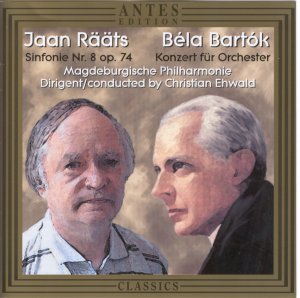
AVAILABILITY
Bella Musica Edition
distribution@bellamusica.de
Bella Musica Edition (Antes Edition)
Eisenbahnstr.30
D-77815 BUHL
Telephone: +49 (0)7223-98550
Telefax: +49 (0)7223-985566
Jan RÄÄTS (b.1932)
Symphony No. 8 Op. 74 (1989) [20.36]
Béla BARTÓK (1881-1945)
Concerto for Orchestra (1943) [40.54]
![]() Magdeburgisches Philharmonie/Christian
Ehwald
Magdeburgisches Philharmonie/Christian
Ehwald
rec. live 21-22 March 2002, Großen Haus des Theaters der Landeshauptstadt.
DDD
![]() ANTES EDITION BM-CD
31.9183 [61.35]
ANTES EDITION BM-CD
31.9183 [61.35]
Distributors
USA:
QUALITON IMPORTS ltd:
24-02 40th Ave,
Long Island, N.Y. 11101
Great Britain:
KINGDOM RECORDS LTD:
Elstree Business Centre
Elstree Way, Borhamwood
GB-Herts WD6 1RX